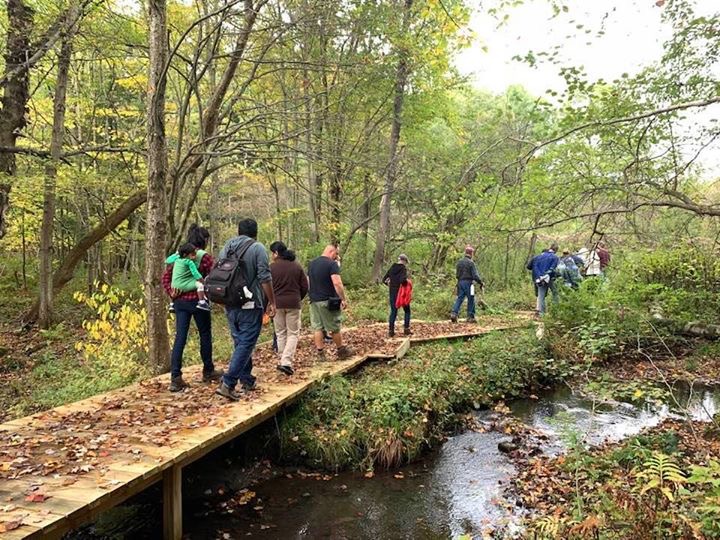Walking Browns Creek Tributary Forest Preserve

Trail improvements at some of CWC's nature preserves, such as this newly-constructed bog bridge at the Browns Creek Tributary Forest Preserve, not only enhance the visitor's experience but also reduce erosion and protect fragile soils and habitat for woodland wildflowers, salamanders and other creatures who call it home. Photo by Jeanne Wiebenga
Earlier this month, I had the pleasure of co-leading a leisurely fall foliage walk at the Chautauqua Watershed Conservancy’s beautiful Browns Creek Tributary Forest Preserve, located at 5014 Walker Road near Bemus Point.
My dear friend and co-leader was land donor, retired biology teacher and preserve steward Dan Anderson, who delighted participants with stories of the trees and the land he’s loved for over 40 years. Dan and his wife Shauna donated the 32-acre parcel to the CWC in 2017, and as the co-owners of Alpacaville on Mahanna Road, even provided delicious alpaca cookies for all to enjoy.
This lovely wooded wetland features well-maintained trails for hiking, birding and botanizing and offers a quiet, peaceful setting for renewing and refreshing one’s body, mind and spirit.
The preserve trailhead greeted our group with tall stands of late summer goldenrod, fuzzy ruby-hued seed heads of joe-pye weed, creamy white boneset flowers, small white asters, bracken fern and blackberry, all giving way at the forest’s edge to more shade-tolerant understory species such as dewberry, dogwood, wood fern and spicebush.
Autumnal foliage displayed its first blush of crimsons, yellows, ochres and scarlets – early reminders of preparations for the winter season to come. Blue jays, chickadees and catbirds called in the distance, and chipmunks scampered and chattered ahead.
As our path led us deeper into the shelter and shade of the forest, the rich earthy fragrance of damp woodland soils and quiet beauty and grace of the trees filled our senses. Red maple, black cherry, cucumber magnolia, yellow birch, swamp hickory, larch and white pine offered opportunity to appreciate and recognize distinctive patterns and features of bark, leaf, buds, fruits and cones and to ponder the interconnected web of life and the many gifts of our watershed forests.
Trees are truly the green guardians of a healthy planet. Their gifts are priceless and essential to life as we know it. Trees generate the oxygen we breathe and cleanse the air as well as filter, detoxify and recycle our water. They hold the earth in place and reduce stormwater runoff and erosion.
They provide nesting sites, resting sites, shelter and food for wildlife and host countless life forms among their roots, trunk, branches and leaves. Trees absorb carbon dioxide from the air, shade and cool their neighbors, buffer against the wind, save energy and reduce the impacts of climate change. Their gifts nourish our spirits and calm and restore the soul. These ancient “standing ones” have much to teach us, and we have much to celebrate.
Wooded wetland trees provide other benefits, too. We are only now beginning to appreciate that these dynamic life-support systems regulate and recharge ground water supplies, filter out and detoxify many man-made pollutants and absorb incredible quantities of heavy metals, organic wastes and sediments.
Their presence minimizes flooding and stabilizes water flow, buffers shorelines and stream sides and protects agricultural soils, reservoirs and navigational channels by slowing water velocity and reducing erosion. Wetland forests also provide unique opportunities for recreation, education, scientific research and personal encounters with the natural world, and for many, their beauty and intrinsic value are beyond measure.
Our meanderings through the Browns Creek tributary forest eventually brought us to the shrubby edge of a beautiful little pond, where willow, viburnum, sedges and grasses lined its shore, and overhanging branches provided shelter and shade at the water’s edge. Pondweeds and lily pads graced the glimmering surface, and butterflies and dragonflies danced overhead.
Life abounded there, where land and water meet.
Distant thunder and a gentle drizzle prompted us to reluctantly return to the woods and conclude our walk, but all were mindful of the gifts of that day’s experience and the treasures of this place.
Our deepest thanks go out to CWC’s many wonderful volunteers, including preserve foreman Craig Seger, preserve steward Dan Anderson, Johnny McCarthy, Bob Lannon, Terry Horner and the volunteer crews from Cummins Jamestown Engine Plant, who have helped improve this preserve’s trails and accessibility (and that of other preserves as well). Thanks, too, to our donors and to those who joined us for our woodland walk.
The recent construction of a 26-foot bridge over the Browns Creek tributary stream, a newly-installed 32-foot bog bridge and other CWC Gateways to Nature Program trail improvements have been made possible thanks to funding from a generous grant from Cummins Engine, Inc, for which we are deeply grateful. These additions not only enhance our visitors’ experience while wetland walking but also reduce erosion and protect fragile wetland soils and habitat for woodland wildflowers, salamanders and other creatures who call it home.
Becky Nystrom is a retired SUNY JCC biology professor, current board president and founding trustee of the CWC, and a longtime CWC volunteer and supporter.
The Chautauqua Watershed Conservancy is a local not-for-profit organization dedicated to preserving and enhancing the water quality, scenic beauty and ecological health of the lakes, streams, wetlands and watersheds of the Chautauqua region. For more information, call 664-2166 or visit chautauquawatershed.org or facebook.com/chautauquawatershed.






